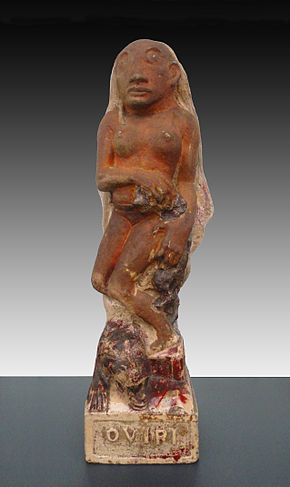
Back Oviri Azerbaijani Oviri Catalan Oviri Czech اوویری Persian Oviri French Oviri Hausa Oviri (szobor) Hungarian Oviri ID اویری MZN Oviri (Gauguin) Uzbek

Oviri (Tahitian for savage or wild)[1] is an 1894 ceramic sculpture by the French artist Paul Gauguin. In Tahitian mythology, Oviri was the goddess of mourning and is shown with long pale hair and wild eyes, smothering a wolf with her feet while clutching a cub in her arms. Art historians have presented multiple interpretations—usually that Gauguin intended it as an epithet to reinforce his self-image as a "civilised savage". Tahitian goddesses of her era had passed from folk memory by 1894, yet Gauguin romanticises the island's past as he reaches towards more ancient sources, including an Assyrian relief of a "master of animals" type, and Majapahit mummies. Other possible influences include preserved skulls from the Marquesas Islands, figures found at Borobudur, and a 9th-century Mahayana Buddhist temple in central Java.
Gauguin made three casts, each in partially glazed stoneware, and while several copies exist in plaster or bronze, the original cast is in the Musée d'Orsay. His sales of the casts were not successful, and at a low financial and personal ebb he asked for one to be placed on his grave. There are only three other surviving comments of his on the figure: he described the figure as a strange and cruel enigma on an 1895 presentation mount of two impressions of a woodcut of Oviri for Stéphane Mallarmé; he referred to it as La Tueuse ("The Murderess") in an 1897 letter to Ambroise Vollard; and he appended an inscription referencing Honoré de Balzac's novel Séraphîta in a c. 1899 drawing.[2] Oviri was exhibited at the 1906 Salon d'Automne (no. 57)[3] where it influenced Pablo Picasso, who based one of the figures in Les Demoiselles d'Avignon on it.[4]
- ^ Maurer, 162
- ^ Landy, 242, 244–46
- ^ "1906 Salon d'automne". Exposés au Grand Palais des Champs-Élysées, 1906. Retrieved 29 August 2015
- ^ Frèches-Thory, 372–73